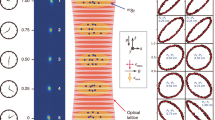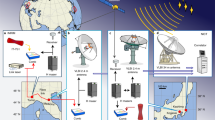Abstract
An exact knowledge of the instantaneous Earth’s rotation rate is indispensable for accurate navigation and geolocation. Fluctuations in the length of sidereal day are caused by momentum exchange between the fluids of the Earth (namely, the atmosphere, hydrosphere and cryosphere) and the solid Earth. Since a multitude of different globally distributed and independent mass transport phenomena are involved, the resultant effect on the Earth’s rotation is not predictable and needs to be continuously measured. Here we report the observation of minute variations in the rotation rate of the Earth at the level of five parts per billion, namely, with a resolution of a few milliseconds over 120 days of continuous measurements. We employ an inertial self-contained measurement technique based on an optical ring laser interferometer rigidly strapped down to the Earth’s crust and operated in the Sagnac configuration. This large-scale gyroscope integrates over three hours for each data point, as opposed to an entire global network of Global Navigation Satellite Systems receivers and Very Long Baseline Interferometry that can only provide a single measurement per day.
This is a preview of subscription content, access via your institution
Access options
Access Nature and 54 other Nature Portfolio journals
Get Nature+, our best-value online-access subscription
$29.99 / 30 days
cancel any time
Subscribe to this journal
Receive 12 print issues and online access
$209.00 per year
only $17.42 per issue
Buy this article
- Purchase on Springer Link
- Instant access to full article PDF
Prices may be subject to local taxes which are calculated during checkout



Similar content being viewed by others
Data availability
The necessary data files and brief file descriptions, raw data files and some relevant auxiliary files are available via Figshare at https://doi.org/10.6084/m9.figshare.23684520. Source data are provided with this paper.
Code availability
The analysis program was graphically coded in LabView and is a complex suite that is neither simple nor fully intuitive to run. It is available via Zenodo at https://doi.org/10.5281/zenodo.8146323, but we recommend that users contact the corresponding author before use. The basic dataset for this publication is available via Zenodo at https://doi.org/10.5281/zenodo.8146444.
Change history
02 October 2023
A Correction to this paper has been published: https://doi.org/10.1038/s41566-023-01320-y
References
Chao, B. F. et al. Space geodesy monitors mass transports in global geophysical fluids. Eos Trans. AGU 81, 247–250 (2000).
Brzezinski, A. Contribution to the theory of polar motion for an elastic Earth with liquid core. Manuscr. Geod. 11, 226–241 (1986).
Agnew, D. C. NLOADF: a program for computing ocean-tide loading. J. Geophys. Res. 102, 5109–5110 (1997).
Ma, C. et al. The International Celestial Reference Frame as realized by Very Long Baseline Interferometry. Astron. J. 116, 516–546 (1998).
Weyl, H. Space, Time, Matter (Dover Publications, 1952).
Lai, Y.-H. et al. Earth rotation measured by a chip-scale ring laser gyroscope. Nat. Photon. 14, 345–349 (2020).
Chao, B. F. As the world turns, II. Eos Trans. AGU 72, 550–551 (1991).
Schreiber, K. U. & Wells, J.-P. R. Rotation Sensing with Large Ring Lasers (Cambridge Univ. Press, 2023).
Schreiber, K. U., Klügel, T. & Stedman, G. E. Earth tide and tilt detection by a ring laser gyroscope. J. Geophys. Res. 108, 2132 (2003).
Schreiber, K. U. et al. Direct measurement of diurnal polar motion by ring laser gyroscopes. J. Geophys. Res. 109, 6405 (2004).
Schreiber, K. U., Klügel, T., Wells, J.-P. R., Hurst, R. B. & Gebauer, A. How to detect the Chandler and the annual wobble of the Earth with a large ring laser gyroscope. Phys. Rev. Lett. 107, 173904 (2011).
IERS Data/Products/Tools; https://www.iers.org/IERS/EN/DataProducts/data.html
Schreiber, K. U. & Wells, J.-P. R. Invited review article: large ring lasers for rotation sensing. Rev. Sci. Instrum. 84, 041101 (2013).
Hurst, R. B., Mayerbacher, M., Gebauer, A., Schreiber, K. U. & Wells, J.-P. R. High-accuracy absolute rotation rate measurements with a large ring laser gyro: establishing the scale factor. Appl. Opt. 56, 1124–1130 (2017).
Hurst, R. B., Rabeendran, N., Schreiber, K. U. & Wells, J.-P. R. Correction of backscatter-induced systematic errors in ring laser gyroscopes. Appl. Opt. 53, 7610–7618 (2014).
Beghi, A. et al. Compensation of the laser parameter fluctuations in large ring-laser gyros: a Kalman filter approach. Appl. Opt. 51, 7518–7528 (2012).
Di Virgilio, A. D. V. et al. Analysis of ring laser gyroscopes including laser dynamics. Eur. Phys. J. D 79, 573 (2019).
Klügel, T. & Wziontek, H. Correcting gravimeters and tiltmeters for atmospheric mass attraction using operational weather models. J. Geodyn. 48, 204–210 (2009).
Bosi, F. et al. Measuring gravitomagnetic effects by a multi-ring-laser gyroscope. Phys. Rev. D 84, 122002 (2011).
Aronowitz, F. The laser gyro. in Laser Applications (ed. Ross, M.) Vol. 1 (Academic Press, 1971).
Schreiber, K. U., Kodet, J., Hugentobler, U., Klügel, T. & Wells, J.-P. R. Variations of the Earth’s rotation rate measured with a ring laser interferometer. Figshare https://doi.org/10.6084/m9.figshare.23684520 (2023).
Acknowledgements
This work has been carried out in the framework of the research program of the Research Group Satellite Geodesy. We acknowledge funding from the Federal Agency of Cartography and Geodesy and the Technical University of Munich. We would like to acknowledge the contributions of R. Hurst, G. Stedman and the late M. Schneider.
Author information
Authors and Affiliations
Contributions
All authors contributed in a meaningful way to the development of the sensor setup over an extended period of time. K.U.S. and J.K. carried out the measurements. K.U.S. provided the analysis and wrote the manuscript. J.-P.R.W. co-wrote the manuscript. T.K. provided the tilt corrections and atmospheric attraction correction model. U.H. provided and verified the geodetic correction methods.
Corresponding author
Ethics declarations
Competing interests
The authors declare no competing interests.
Peer review
Peer review information
Nature Photonics thanks Christian Bizouard, Lute Maleki and the other, anonymous, reviewer(s) for their contribution to the peer review of this work.
Additional information
Publisher’s note Springer Nature remains neutral with regard to jurisdictional claims in published maps and institutional affiliations.
Supplementary information
Supplementary Data 1
A ring laser shows systematic errors caused by the presence of a gain medium in the cavity. We have modelled the backscatter and null shift to remove these errors. This tab-delimited data file provides these crucial corrections at high sensor resolution (averaged over 3 h).
Supplementary Data 2
A ring laser is sensitive to changes in orientation. This tab-delimited data file provides the tilt experienced by the gyro as well as the temperature correction of the tiltmeter and atmospheric attraction on the sensor as a function of time.
Source data
Source Data Fig. 1
The file contains the time deviation values of the ring laser measurements in a tab-delimited text file with the geophysical signals removed, so that it shows the instrumental resolution. There are three columns in this text file, containing the length of the averaged time interval, averaged rotation rate (normalized to the rotation rate of the Earth) and the averaged rotation rate.
Source Data Fig. 2
This tab-delimited text file shows the corrected ring laser measurements in units of milliseconds as a function of time along with the length-of-day signal, derived from the C04 dataset, which has been taken from the IERS.
Source Data Fig. 3
The tab-delimited text file for Fig. 3a contains the ring-laser-measured Earth’s rotation signal along with the accumulated contribution of the modelled geophysical signals as a function of time. Columns 2 and 3 are in units of hertz. Columns 4 and 5 are in units of microhertz. A constant offset value has been subtracted from columns 4 and 5 to achieve better display of the diagram. The tab-delimited text file for Fig. 3b contains the power spectral densities of the reduced ring laser measurements and the corresponding mass transport signal.
Rights and permissions
Springer Nature or its licensor (e.g. a society or other partner) holds exclusive rights to this article under a publishing agreement with the author(s) or other rightsholder(s); author self-archiving of the accepted manuscript version of this article is solely governed by the terms of such publishing agreement and applicable law.
About this article
Cite this article
Schreiber, K.U., Kodet, J., Hugentobler, U. et al. Variations in the Earth’s rotation rate measured with a ring laser interferometer. Nat. Photon. 17, 1054–1058 (2023). https://doi.org/10.1038/s41566-023-01286-x
Received:
Accepted:
Published:
Issue Date:
DOI: https://doi.org/10.1038/s41566-023-01286-x
This article is cited by
-
How lasers detect day-length changes of a few milliseconds
Nature (2023)
-
Laser gyroscope precisely tracks the Earth’s rotation
Nature Photonics (2023)



